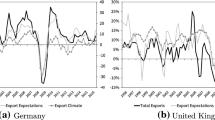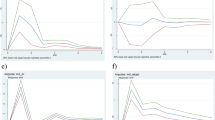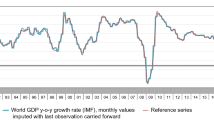Abstract
Business survey, which starts from the microeconomic level, is a widely used short-term forecasting tool in practice. In this study, the authors examine whether foreign trade survey data collected by China’s Ministry of Commerce would provide reliable forecasts of China’s foreign trade. The research procedure is designed from three perspectives including forecast information test, turning point forecast, and out-of-sample value forecast. First, Granger causality test detects whether survey data lead exports and imports. Second, business cycle analysis, a non-model based method, is performed. The authors construct composite indexes with business survey data to forecast turning points of foreign trade. Third, model-based numerical forecasting methods, including the Autoregressive Integrated Moving Average Model with Exogenous Variables (ARIMAX) and the artificial neural networks (ANNs) models are estimated. Empirical results show that survey data granger cause imports and exports, the leading composite index provides signal for changes of trade cycles, and quantitative models including survey data generate more accurate forecasts than benchmark models. It is concluded that trade survey data has excellent predictive capabilities for imports and exports, which can offer some priorities for government policy-making and enterprise decision making.
Similar content being viewed by others
References
Pesaran M H, Formation of inflation expectations in British manufacturing industries, The Economic Journal, 1985, 95(380): 948–975.
Mogliani M, Darné O, and Pluyaud B, The new MIBA model: Real-time nowcasting of French GDP using the Banque de France’s monthly business survey, Economic Modelling, 2017, 64: 26–39.
Yaprak A, An empirical study of the differences between small exporting and non-exporting US firms, International Marketing Review, 1985, 2(2): 72–83.
Kim S J, Intraday evidence of efficacy of 1991–2004 yen intervention by the Bank of Japan, Journal of International Financial Markets, Institutions and Money, 2007, 17(4): 341–360.
Fernández-Villaverde J and Krueger D, Consumption over the life cycle: Facts from consumer expenditure survey data, Review of Economics and Statistics, 2007, 89(3): 552–565.
Yu L A, Wang S Y, and Lai K K, Forecasting Chinas foreign trade volume with a kernel-based hybrid econometrical ensemble learning approach, Journal of Systems Science & Complexity, 2008, 21(1): 1–9.
Zheng G H, Guo L, Jiang X M, et al., The impact of RMB’s appreciation on China’s trade, Asia-Pacific Journal of Accounting & Economics, 2006, 13(1): 35–50.
Yue C J and Hua P, Does comparative advantage explains export patterns in China, China Economic Review, 2001, 13(23): 276–296.
Lü Y H, Influence factors of China import and export trade flows: Empirical study on trade gravity model by panel data, On Economic Problems, 2009, 47: 777–780.
Du T, The international trade shocks and the China’s business cycle, Journal of International Trade, 2006, 12(2): 14–19.
Nasreen S and Anwar S, Causal relationship between trade openness, economic growth and energy consumption: A panel data analysis of Asian countries, Energy Policy, 2014, 69: 82–91.
Singh T, Business cycle dynamics of economic growth in the OECD countries: Evidence from markov-switching model, Review of Economic Analysis, 2016, 8(1): 47–68.
Stock J H and Watson M W, Indicators for dating business cycles: Cross-history selection and comparisons, American Economic Review, 2010, 100(2): 16–19.
Stock J H and Watson M W, Estimating turning points using large data sets, Journal of Econometrics, 2014, 178: 368–381.
Fidrmuc J and Korhonen I, Meta-analysis of the business cycle correlation between the euro area and the CEECs, Journal of Comparative Economics, 2006, 34(3): 518–537.
Hamilton J D, A new approach to the economic analysis of nonstationary time series and the business cycle, Econometrica: Journal of the Econometric Society, 1989, 57(2): 357–384.
Carriero A and Marcellino M, A comparison of methods for the construction of composite coincident and leading indexes for the UK, International Journal of Forecasting, 2007, 23(2): 219–236.
Zhang J, Hassani H, Xie H, et al., Estimating multi-country prosperity index: A two-dimensional singular spectrum analysis approach, Journal of Systems Science & Complexity, 2014, 27(1): 56–74.
Shiskin J, The X-11 Variant of the Census Method II Seasonal Adjustment Program (No. 15), US Government Printing Office, 1965.
Fukuda S I and Onodera T, A new composite index of coincident economic indicators in Japan: How can we improve forecast performances? International Journal of Forecasting, 2001, 17(3): 483–498.
Stock J H and Watson M W, A simple estimator of cointegrating vectors in higher order integrated systems, Econometrica: Journal of the Econometric Society, 1993, 61(4): 783–820.
Moore G H, Statistical Indicators of Cyclical Revivals and Recessions, Business Cycle Indicators, Volume 1 (pp. 184–260), Princeton University Press, 1961.
Moore G H and Klein P A, Forecasting Foreign Trade with Leading Indicators, Problems and Instruments of Business Cycle Analysis (pp. 157–181), Springer, Berlin, Heidelberg, 1978.
Anggraeni W, Andri K B, Sumaryanto, et al, The performance of ARIMAX model and Vector Autoregressive (VAR) model in forecasting strategic commodity price in Indonesia, Procedia Computer Science, 2017, 124: 189–196.
Co H C and Boosarawongse R, Forecasting Thailand’s rice export: Statistical techniques vs. artificial neural networks, Computers and Industrial Engineering, 2007, 53(4): 610–627.
Tümer A E and Aytekin A, Forecasting gross domestic product per capita using artificial neural networks with non-economical parameters, Physica A: Statistical Mechanics and Its Applications, 2018, 512: 468–473.
Anggraeni W, Andri K B, and Mahananto F, The performance of ARIMAX model and vector autoregressive (VAR) model in forecasting strategic commodity price in Indonesia, Procedia Computer Science, 2017, 124: 189–196.
Wangdi K, Singhasivanon P, Silawan T, et al, Development of temporal modelling for forecasting and prediction of malaria infections using time-series and ARIMAX analyses: A case study in endemic districts of Bhutan, Malaria Journal, 2010, 9(1): 251–259.
Granger C W, Investigating causal relations by econometric models and cross-spectral methods, Econometrica, 1969, 37(3): 424–438.
Dong J, Dai W, and Li J, Exploring the linear and nonlinear causality between internet big data and stock markets, Journal of Systems Science & Complexity, 2020, 33(3): 783–798.
Zhang X, Lai K K, and Wang S, Did speculative activities contribute to high crude oil prices during 1993 to 2008? Journal of Systems Science & Complexity, 2009, 22(4): 636–646.
Frankel J and Saravelos G, Can leading indicators assess country vulnerability? Evidence from the 2008–2009 global financial crisis, Journal of International Economics, 2012, 87(2): 216–231.
Harvey A C and Jaeger A, Detrending, stylized facts and the business cycle, Journal of Applied Econometrics, 1993, 8(3): 231–247.
Filardo A J, Business-cycle phases and their transitional dynamics, Journal of Business and Economic Statistics, 1994, 12(3): 299–308.
Wei Y J, Wei Q, Wang S Y, et al., A hybrid approach for studying the lead-lag relation- ships between China’s onshore and offshore exchange rates considering the impact of extreme events, Journal of Systems Science & Complexity, 2017, 31(3): 734–749.
Maia A L S and de Carvalho F D A, Holt’s exponential smoothing and neural network models for forecasting interval-valued time series, International Journal of Forecasting, 2011, 27(3): 740–759.
Malik F and Nasereddin M, Forecasting output using oil prices: A cascaded artificial neural network approach, Journal of Economics and Business, 2006, 58(2): 168–180.
Sun Y, Zhang X, and Wang S, A hierarchical forecasting model for China’s foreign trade, Journal of Systems Science & Complexity, 2020, 33(3): 743–759.
Chiroma H, Abdulkareem S, and Herawan T, Evolutionary neural network model for West Texas intermediate crude oil price prediction, Applied Energy, 2015, 142: 266–273.
Acknowledgements
We are grateful to the Ministry of Commerce, People’s Republic of China for providing data.
Author information
Authors and Affiliations
Corresponding authors
Additional information
This paper was partially supported by the National Natural Science Foundation of China under Grant Nos. 71422015, 71988101, and the National Center for Mathematics and Interdisciplinary Sciences, Chinese Academy of Sciences.
This paper was recommended for publication by Editor FANG Ying.
Rights and permissions
About this article
Cite this article
Bai, Y., Wang, S. & Zhang, X. Foreign Trade Survey Data: Do They Help in Forecasting Exports and Imports?. J Syst Sci Complex 35, 1839–1862 (2022). https://doi.org/10.1007/s11424-022-1015-x
Received:
Revised:
Published:
Issue Date:
DOI: https://doi.org/10.1007/s11424-022-1015-x




